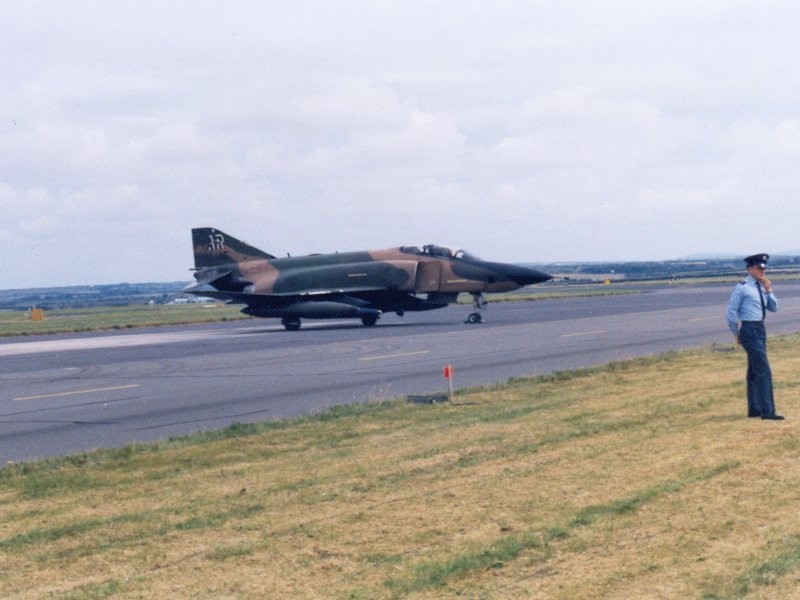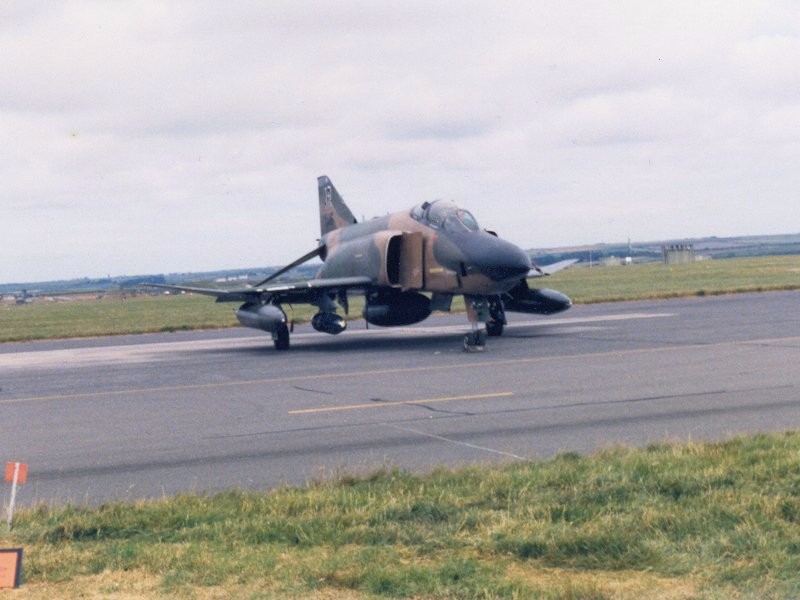
ASN Wikibase Occurrence # 56868
This information is added by users of ASN. Neither ASN nor the Flight Safety Foundation are responsible for the completeness or correctness of this information.
If you feel this information is incomplete or incorrect, you can submit corrected information.
| Date: | Thursday 24 July 1986 |
| Time: | approx 1530 |
| Type: |  McDonnell Douglas RF-4C Phantom |
| Owner/operator: | 10th TRWg USAF |
| Registration: | 72-0146 |
| MSN: | 4306 |
| Fatalities: | Fatalities: 2 / Occupants: 2 |
| Aircraft damage: | Destroyed |
| Location: | Newgale Beach, St.Bride's Bay, off RAF Brawdy, Dyfed,Wales -
 United Kingdom United Kingdom
|
| Phase: | Manoeuvring (airshow, firefighting, ag.ops.) |
| Nature: | Military |
| Departure airport: | RAF Brawdy, Dyfed, Wales (EGDA) |
| Confidence Rating: |
Crashed whilst giving a display at the air show at RAF Brawdy. Weather was pretty standard for Brawdy - bloody awful!
Aircraft took off, performed a "medium" speed run Right-to-Left (South-to-North along runway 02/20) turned and flew a slow and low pass in the opposite direction. Whilst cleaning up and turning on the crowd at 45 degrees to prepare for a final high speed run, it was lost from sight behind one of Brawdy's many "humps". I was in extreme crowd right (south end of display runway and still could not see the accident area (St Brides Bay)
According to a later testimony (in 2013 - see link #3) the fact that the aircraft climbed at a high angle of attack, allowed the fuel in the centre line tank to collect at the aft section, as there were no "baffles" to prevent the fuel from "slopping fore and aft" as the aircraft manouvred. The accumulation of fuel in the aft section of the centre line tank affected the aircraft's C of G, causing instability of the aircraft's handling. At the very low altitude the F-4 was flying, it was impossible to recover from the C of G imbalance.
I Recall that BBC Radio 1 reported the accident within the hour pronouncing two crew dead: incredibly quick news turn around considering the location.
Local TV news that night had the sad sight of the "AR" coded fin sticking out of the water like a beached shark. According to newspaper reports at the time, the navigator in the rear seat managed to eject, but the pilot did not, and his body was recovered from the wreckage of the aircraft.
Crew later named as Captain Mark Makowski (pilot) and 2nd Lt Dewayne Danielson (navigator)
*************************************
I was an eye witness to the final minute, or so, of flight.
The aircraft had been part of the "static" display and it was unclear as to whether the crew were properly authorised to carry out a display on their departure. I was a pilot based at RAF Brawdy and was driving my young son home at the conclusion of the flying display. I was in the car at the top of Newgale Hill when the F4 flew low over my head as we both headed south. The weather was clear below a cloudbase of 6/8 at approximately 2,000'. The F4 was relatively slow in "cold" power when it passed over me at about 200' and it descended slightly over Newgale Beach and turned gently left onto approximately 190degs for about 8 seconds before commencing a fairly aggressive level turn (almost planform to me) to the right (presumably to run back over the airfield in a northerly direction). Shortly after this the aircraft started to sink and the characteristic increase in smoke occurred as reheat was engaged and the angle of bank was reduced slightly. As the aircraft continued the right turn through a westerly heading, and was 90-off to me and about 1200 yards away, it was apparent that the angle of attack had increased having bled off airspeed in the first 90 of the turn. The right turn and the gentle rate of descent continued until passing an approximate heading of NW whereupon I observed several oscillations in the angle of bank("wing rock") and the rate of descent increased. At about 50' ASL and at low speed/high AOA, the ac rolled to the left and struck the sea left wing low about 300 yards SW of my elevated position as I drove down NewGale Hill and about 80 yards off the shore in shallow water. The WSO ejected very low/late (the canopy came off and the seat fired but almost immediately struck the water. I don't remember seeing the drogue gun fire - the parachute did not have time to deploy. The pilot did not eject. I drove quickly down to a small shop at the bottom of the hill and put through a FLASH call to Brawdy 22 Sqn to ask if they could put a Diver on board the SAR Sea-King as the pilot was still in the cockpit.
I had flown against F4's for many years in DACT and had witnessed the slow-speed/high AOA characteristics of these aircraft at close quarters. Sadly, this was a relatively heavy ac, with a centre-line fuel tank fitted, that was asked to do more than it was capable of under those circumstances.
Interestingly, I don't recall the USAF ever interviewing any of us over this avoidable accident.
Sources:
1. http://www.flightglobal.com/pdfarchive/view/1986/1986%20-%201877.html
2. http://www.midwaysailor.com/photos/phantom-rf4c.html
3. https://www.pprune.org/military-aircrew/107948-10-trw-rf-4c-crash-1986-raf-brawdy-airshow.html
4. http://www.joebaugher.com/usaf_serials/1972.html
5. http://www.usfallenwarriors.com/index.php?page=directory&rec=45698
6. http://www.wwwmp.co.uk/pembrokeshire/brawdy-raf-burials-casualties/
7. http://peacetime-casualties.findthebest.com/l/13122/Mark-S-Makowski
8. http://www.westerntelegraph.co.uk/news/9163011.25_years_since_tragic_air_crash_claimed_two_lives/
Images:

RAF Brawdy, Wales, July 24, 1986 ~ Day of the accident, just before takeoff.

RAF Brawdy, Wales, July 24, 1986 ~ Day of the accident, just before takeoff.
Revision history:
| Date/time | Contributor | Updates |
|---|---|---|
| 06-Jan-2009 06:19 | harro | Added |
| 18-Nov-2011 08:07 | Dr. John Smith | Updated [Cn, Operator, Location, Phase, Departure airport, Source, Narrative] |
| 29-May-2013 14:34 | Dr. John Smith | Updated [Nature, Source, Embed code, Narrative] |
| 13-Aug-2013 14:02 | MidwaySailor | Updated [[Nature, Source, Embed code, Narrative]] |
| 13-Aug-2013 14:02 | MidwaySailor | Updated [[[Nature, Source, Embed code, Narrative]]] |
| 30-Oct-2014 00:52 | Dr. John Smith | Updated [Source, Embed code] |
| 30-Oct-2014 01:06 | Dr. John Smith | Updated [Source, Narrative] |
| 09-Feb-2017 17:46 | Anon. | Updated [Embed code] |
| 09-Feb-2017 17:47 | harro | Updated [Embed code] |
| 30-May-2021 10:15 | Anon. | Updated [Operator, Operator] |
| 19-Jul-2022 17:42 | ODR | Updated [Time, Nature, Narrative] |
Corrections or additions? ... Edit this accident description
The Aviation Safety Network is an exclusive service provided by:


 ©2024 Flight Safety Foundation
©2024 Flight Safety Foundation